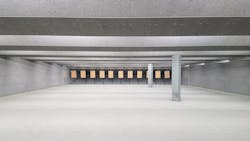Troy Acoustics founder Bill Bergiadis spoke to OFFICER Magazine about the importance of range design.
How does Troy Acoustics help plan a range?
We like to be there in the early planning stages for a station. If the range is an afterthought and stuck down in the basement, that’s when the audibility of gunfire sound levels occurs. What is going to be adjacent to this range? You don’t want your 911 call center hearing gunfire in the background, and not hearing the caller for help. Or the gunfire sound levels transmitting into the interview rooms. You definitely don’t want the range next to or underneath the chief’s office. Location is an important choice, as is the acoustic isolation of the gunfire sound level from being INTRUSIVE to the other spaces.
What are some of the current issues and trends?
One of the current issues in the industry is the need for a dynamic range. That need to move within the range space and train for all possible realistic scenarios. Fixed point ranges don’t provide the realistic scenario training the LEOs need to protect the public and stay alive. So, the planning for enough space is essential. With that required space are the ventilation, the ballistic containment and the access and egress for vehicles onto the space. Then, most importantly, the acoustics MUST cover all these walls and overhead baffles or concrete decks to protect the shooter and instructors from exceeding their OSHA noise exposure limits.
What role do Troy Acoustics’ products play in helping control sounds levels at ranges?
Let’s start with a course in Acoustics 101. We design with two criteria in mind: the barrier function of acoustics to mitigate loud noise going into other areas and the absorption function of acoustics, to lessen the reverberations that effects the subjects in the range.
Does over-ear protection take care of noise exposure?
The entire body is exposed to the blast overpressure during live fire training in range. Your hearing protection does not protect your organs or your head or your hips and knee joints. The muzzle blast energy from firearms is a small IED going off every pull of the trigger. These smaller IEDs exhort pressure (PSI) in the entire range space, all round (front-back-side to side). As a shooter, you feel the muzzle blast energy (PSI) from the guys to your right and left. As an instructor you feel the pressure (PSI) from all the shooters in front of you.
What tips would you give an agency planning a range?
The main tip is don’t listen to some sales guy when it comes to choosing acoustics. A lot of our work comes from re-doing work on ranges suffering from poor design. It’s a lot easier and less costly when you get it right the first time.


